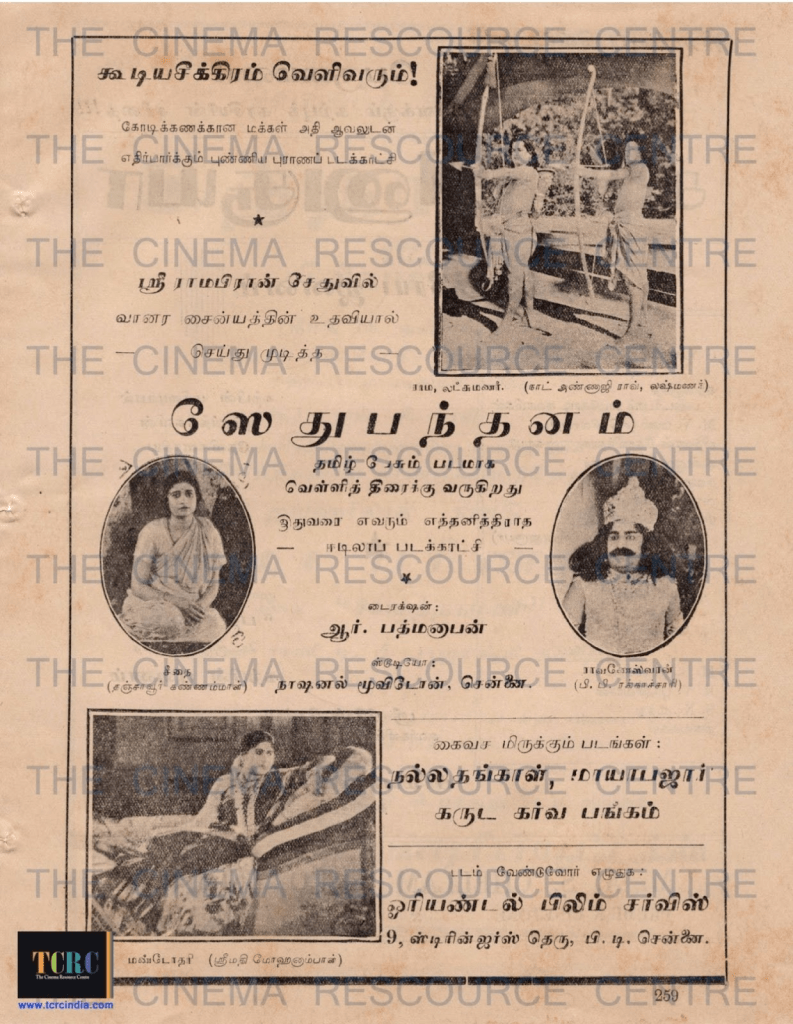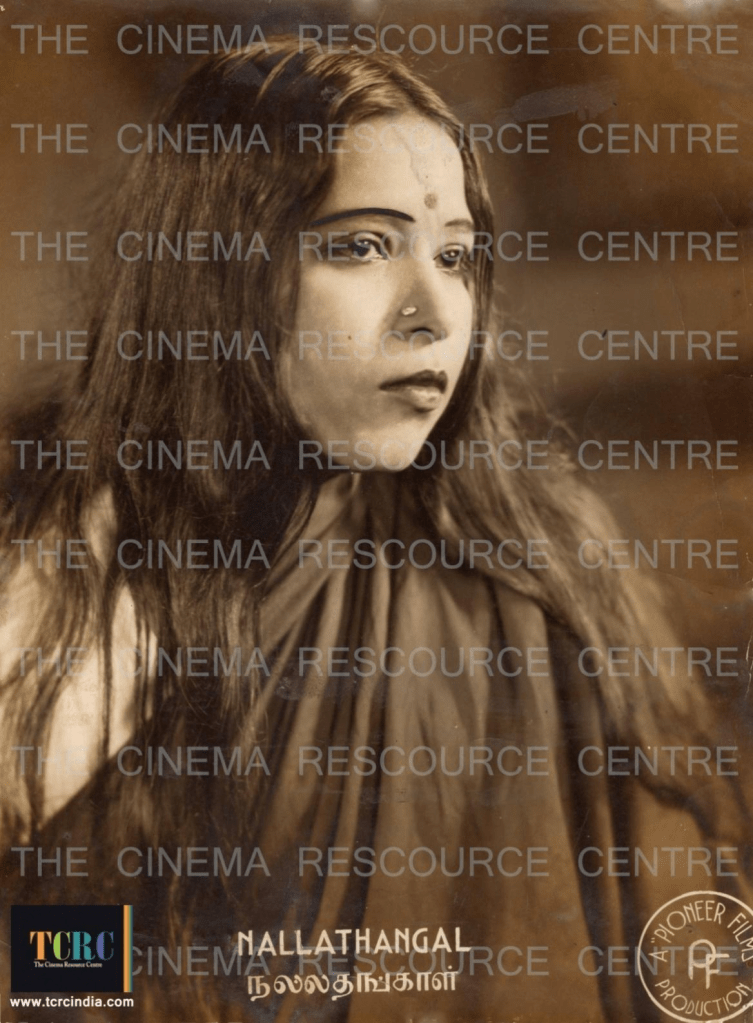I DIRECTORS: THE CAPTAINS – MASTERS AND COMMANDERS WITH AN IMPACT TO LAST THE AGES
8) R. Padmanabhan
Rangasami Padmanabhan, also known as R. Padmanabhan, is one of the pioneers of Tamil Cinema. Sadly, few people remember or talk about him today, except for a few old-timers and film historians.
Padmanabhan was born in Sivaganga in 1895 into a middle-class family. His interest in cinema grew while he was in Colombo, where he began arranging exhibitions for an English distributor. Later, he moved to Madras and established his own firm, Oriental Film Services, which provided services such as bringing films from Bombay or Hollywood, arranging spares for film equipment, and assisting with miscellaneous film-related work. With the help of K.S. Venkatramani, who happened to be the father-in-law of the legendary filmmaker K. Subramanyam, Padmanabhan started the Madras-based Associated Film Studios. The production studio was the second-largest in South India at the time, followed only by General Pictures.
Padmanabhan made a name for himself in the silent era, and was responsible for launching the career of K. Subramaniyam, the lawyer turned filmmaker who began as a screenwriter for Padmanbhan but later became a revolutionary filmmaker with films such as SEVASADHANAM and THYAGABHOOMI.
Padmanabhan also brought another trendsetting filmmaker, Raja Sandow, to the forefront through the silent film ANADHAI PENN in 1929. This film marked the launch of Padmanabhan’s own Associated Film Studios, and it was quite successful upon its release in 1931. Unfortunately, it is now one of the many lost films from the silent era. Raja Sandow continued to work for Padmanabhan, and several silent films were made, through which K. Subramaniyam also received training.
When Tamil films began to talk — ie. feature sound — in 1931, Padmanabhan, who had made many silent films, began making talkies in both Tamil and Telugu. He established a production company, Oriental Film Services, in partnership with Ramalinga Mudaliar. Most of his films were shot at Pioneer Studios in Calcutta. His first talkie film as a director was DRAUPATHI VASTRAPAHARANAM, which was released in 1934. The film was produced in Calcutta by the Salem-based production company Angel Films.

An advertisement of Oriental Film Services mentioning SETHU BANDHANAM, NALLATHANGAL,
MAYA BAZAAR and GARUDAGARVABHANGAM all 4 films directed by R. Padmanabhan
From the magazine ANANDHA VIKATAN DEEPAVALI MALAR 1936
PC: From the archives of TCRC
Following the release of DRAUPATHI VASTRAPAHARANAM, Padmanabhan had two more releases in 1935: NALLA THANGAL, and MAYA BAZAAR, also known as VATSALA KALYANAM.
NALLA THANGAL is a story based on Hindu mythology about a mother of the same name who, along with her seven children, commits suicide by jumping into a well due to severe famine caused by barren lands, humiliation, and insults from society. Her brother, upon learning of this tragedy, also jumps into the well and takes his own life. After her death, Nalla Thangal becomes a village deity, and there are temples dedicated to her. Though many films have been made based on this story, R. Padmanabhan’s NALLA THANGAL, produced by Pioneer Films, was one of the first, along with P.V. Rao’s version, released in the same year under the same name, for Angel Films.

A still from the Movie NALLATHANGAL Featuring P.S.Rathnabhai
PC: From the archives of TCRC
The film featured P.S. Rathanabhai in the titular role, with M.R. Krishnamurthy, M.S. Murugesan, and P.S. Saraswathibhai among the supporting cast. Rathanabhai and Saraswathibhai, who were siblings in real life and known as the Palayamkottai Sisters, often worked together as a team in many films. They were reportedly paid a combined fee of Rs. 25,000 for a 45-day shoot, with any extensions incurring additional payment.

A still from the Movie NALLATHANGAL Featuring P.S.Rathnabhai and P.S. Saraswathibhai
PC: From the archives of TCRC
R. Padmanabhan’s film, SETHU BHANDHANAM, ranks among the top in the most successful films chart of Padmanabhan. The film was based on the Hindu epic Ramayana, where Rama builds a bridge to Lanka with the help of his devotee Hanuman and his friends to fight Ravana and rescue his abducted wife Seetha. This bridge was called Sethu Bhandanam.
P.B. Rangachari, a famous star then, acted in the role of Ravanan, while Nott Annaji Rao essayed the character of Rama, and M.S. Mohanambal played Ravanan’s wife Mandothari. Alongside them, T.K. Kannammal acted in the role of Seetha. M.D. Parthasarathy acted in the much-applauded role of Hanuman, who later went on to become one of the most established Carnatic musicians in the country, and a film music composer to boot. His performance as Hanuman is considered a big plus towards the stupendous success of the movie. Padmanabhan later made a Telugu version of the film with the same name in 1946, which also turned out to be a profitable venture.

A still from the Movie SETHUBHANDHANAM Featuring P.B. Rangachari
PC: From the archives of TCRC
[To be continued] We’ll be back next week with more hidden treasure from the history of Tamil cinema. Stay tuned!
About the Author:

V.V. Prasad is a Electronics and Communication Engineer based from Chennai. He is currently involved in the role of a Researcher and Archivist in THE CINEMA RESCOURCE CENTRE.
He takes care of the non film materials like Photographs, Magazines, Lobby Cards, Song books etc of the archives. Cataloguing them and digitizing them are part of his current work.
His interests and passion lie on the research of Cinema particularly South Indian Cinema.
